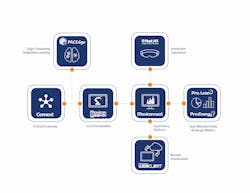Edge computing has become big business.
Indeed, market research firm International Data Corporation (IDC), Needham, Massachusetts, forecasts that spending on edge computing will reach roughly $274 billion by 2025, up from $176 billion in 2022.
The lion’s share — 85% — will be spent on edge hardware, the balance on software with edge analytics, virtual network functions and content delivery networks.
Manufacturing operations are among the top investors in the technologies.
“As edge technology continues to expand in usage in a variety of workplace environments, we are seeing growing interest in expected concurrent workload growth in areas such as business intelligence and analytics, artificial intelligence/machine learning (AI/ML)-related workloads and content workloads,” says IDC senior research analyst Max Pepper.
Similarly, in its report “Opportunities and Challenges at the Industrial IoT Edge,” ARC Advisory Group, Houston, notes that industrial edge deployments have matured significantly in recent years as organizations increasingly recognize their value and benefits.
The initial proof of concept stage, which primarily focused on exploring the feasibility and potential of the Internet of Things (IoT) edge technologies, is now transitioning to full-scale projects. This shift, says the report, is driven by the growing realization that IoT edge technology can address critical challenges such as latency, bandwidth limitations and data privacy concerns in industrial environments.
So, the industrial market is increasingly recognizing the benefits of edge-to-cloud integration and edge computing, driving the adoption of these technologies to enhance their operational capabilities and gain a competitive advantage. ARC’s own technology survey in 2022 found that over one-third of users are deploying these technologies, and almost half are in the process of evaluating them.
Concurrent with this trend, the report notes the entrance of an increasing number of edge-specific applications and services. As more suppliers targeting the industrial edge enter the market, they bring with them technologies tailored to specific industrial use cases. These applications empower users to leverage IoT edge technology to optimize their operations, improve efficiency and unlock new insights from their data. The abundance of mature and specialized edge applications further accelerates the transition from pilot projects to large-scale deployments as users can now choose from a wide range of proven technologies that meet their specific needs.
“Modern enterprises are increasingly investing in industrial IoT edge technology. It enables real-time data processing, analysis and decision-making at or near the point of data generation, reducing latency, enhancing efficiency and enabling quick responses in industrial operations. The industrial edge encompasses a range of hardware and software components that work together to support critical applications and services in industrial environments,” notes ARC Advisory Group research analyst Patrick Arnold.
Working at the Edge
What does this mean in reality?
Bill Paczkowski, senior product manager for Emerson’s edge analytics platform PACEdge, based in Milwaukee, cites an example of working with a chemicals management company whose customer, a pulp and paper manufacturer, wanted to improve the lifespan of its rotating equipment and decrease unplanned downtime.
“We suggested a simple architecture with an array of sensors, a few edge computers, and a wireless gateway. They were initially quite apprehensive when the topic of edge was brought up. Data security, hardware reliability and analytic accuracy were on their top list of concerns,” he shares.
To assuage their concerns, Paczkowski and the chemical management company worked closely with the customer to build a system, installing sections of cable, sensors and enclosures in the “splash zone” to show the reliability of the hardware.
Then they walked engineers from the pulp and paper company through the latest round of penetration testing to ease their concerns about data security.
Within a few months of the new monitoring system going live, it notified a high probability of failure in one of the pump drives. A swap-out was needed.
“Fortunately for them, they were able to contact the OEM and get an inspection done the next day. Further analysis would indicate a high concentration of chromium in the oil, an indication of an impending bearing failure. Needless to say, with their fears out of the way, we were able to implement a wide array of edge solutions, improving their process reliability, reducing maintenance costs and right-sizing their replacement part inventory,” Paczkowski explains.
Meanwhile, 3M, Maplewood, Minnesota, which produces more than 60,000 products across its safety and industrial, transportation and electronics, healthcare and consumer business groups, had a quite different issue.
At one of its U.S. plants, increasing the efficiency of its manufacturing lines was often time-consuming and labor-intensive. It was difficult to gather, transfer and use data from the production systems. The data from the two lines arrived at different times and the plant’s network connectivity was limited.
So, 3M’s corporate research lab partnered with the local manufacturing team, and together they identified an opportunity to predict anomalies and then use those insights to reduce manufacturing downtime at the facility. They proposed integrating data streams from two production lines, correlating them and then running analytics and machine learning locally.
To get the performance, management and security needed, the team built a custom module with Microsoft Azure SQL Edge deployed through Microsoft Azure IoT Edge.
The goal was to push data from the plant’s on-premises SQL Server to Azure SQL Edge, enable downstream applications to use the data stored in the SQL Edge device, and then upload it to the cloud.
When 3M was developing an algorithm that allowed them to predict problems on the manufacturing line hours before they appeared, they created an IoT edge solution for the algorithm. “The module sits on our Azure IoT Edge device. It’s cloud trained and deploys to Azure SQL Edge, where the manufacturing line data resides and operates seamlessly to create predictions,” says 3M data systems manager Aaron Burstein, now at Amazon.
By correlating and analyzing two data streams, one with sensor data about the manufacturing equipment and the other product information as it went through the line, it was possible to apply analytics and machine learning to the data. Using Azure SQL Edge, the team created a solution to sync data from there to the cloud, which Burstein says is “fault-tolerant” under almost any network condition.
“And once it was in the cloud, we could bring in all our machine learning tools — Azure Machine Learning Studio, HDInsight Machine Learning Services and our Databricks clusters. We’d never had that capability there to be able to visualize it and use some of the compute in the cloud,” he adds.
Using SQL Edge also resolved the plant’s problem of limited network capacity. When engineers began processing data at the edge, their efficiency increased because they could continue operating even when the plant was offline.
The plant’s pivot to edge computing, which reduced latency, also saved 3M time. Moving data from the plant to Azure went from taking weeks to just minutes. Previously, an export of an SQL dataset was uploaded into SharePoint, spun up with virtual machines and restored back to a database into a subscription or an SQL service in the cloud.
According to Microsoft, working at the edge has been a breakthrough for the local manufacturing team.
“Data processing at the edge is really attractive because it takes your local process and pushes it to a device that I call a bridge to the cloud. Our plant engineer can use their existing processes and tools and do everything locally while connecting with the same SQL codebase at the edge,” shares Burstein.
3M data engineer Libby Oliver notes it took only one engineer an average of six hours to add Azure SQL Edge into the company’s current stack business processes. Prior manual steps, which now take minutes, took weeks.
“Without the consistent SQL codebase, we’d have to write a lot more code, and coordinate between each module of the code we wrote,” Oliver explains. “It would be a lot more work for us to provide, coordinate and manage the modules. There would be much more custom monitoring, amendments and support,” she adds.
In another quite different application, Bayer, Leverkusen, Germany, has been partnering with Microsoft since August 2021 to focus on edge-related projects involving digital farming technologies and data science capabilities.
The first combines the German company’s AgPowered Services with Microsoft’s Azure Data Manager for Agriculture. The idea here is to use high-quality data to provide insights to make the value chain from its crop science division to farmers more predictable and transparent (Figure 1).
The second has led to the development of a data engineering and data science platform called ALYCE. Based on Microsoft Azure, it uses AI and ML to help Bayer evaluate clinical-trial data from all around the world faster and more efficiently — the hope being to reduce the roughly 12 years it takes for a new drug to reach the market.
Edging Ahead
Challenges remain, however.
In the ARC report, Arnold notes several issues that could impede widespread implementation of industrial IoT edge technology.
One is the uncertainty caused by a rapidly evolving market involving a complex web of hardware, software and service providers that users must navigate to deploy their installations.
“Integrating new technological developments and industry standards can be daunting, and legal and regulatory hurdles create additional complications. The industrial IoT edge space is uniquely challenging due to the presence of legacy systems and islands of automation that can be costly and time-consuming to transform,” said Arnold in his report.
On the other hand, Arnold believes enterprises that confront and overcome these challenges will unlock the potential of industrial IoT edge technology.
Paczkowski agrees but also points to the lack of IT and OT skills in the chemical industry, which will “without a doubt” act as an initial barrier for many would-be participants. Another concern is cybersecurity. Here, he believes, the best vendors will stand behind their products with routine security updates and patches.
“As the industrial economy continues to demand more efficient manufacturing methods, even the smaller players will have ample incentives to expedite the integration of new edge technologies. However insurmountable the current challenges may seem, the benefits are far too enticing to allow companies to remain sedentary with regards to adopting edge technologies,” he adds.
And this enticement will only grow, Paczkowski believes, as AI helps push advances in energy utilization and drive more sustainable technologies.
“Edge technologies have enabled us to programmatically change the way we approach actionable insights. As new technologies emerge in data storage and processing, we will see the promotion of greater analytical capability and an overall improvement in the way we approach insights, both actionable and automated. Similar to how we saw massive improvements through lean initiatives supported by the rise of industrial automation, we will see the next generation of operational improvements with the rise of AI, primarily through the utilization of both machine learning and deep learning models.”
As for companies considering edge installations but balking at the challenges involved, Paczkowski has sage advice.
Firstly, he notes that, as with any capital project, an inherent level of risk is involved. However, where edge technologies are concerned, he points to a few simple ways to limit the exposure level.
“For example, the best chance for success is to start small, and partner with a solutions provider that has a long history of supporting their products and working as part of a team dedicated to customer success. Quick wins help to sell solutions internally. The faster the team sees the value in a smaller project, the better the chances for success with the larger projects.”
Secondly, inquire with vendors about additional training.
Finally, don’t be afraid to test out different technologies to ensure they are the right fit for your application and your team.
“Edge use cases can be as simple as data collection for historical analysis, or network gateways bringing together islands of automation. They should not always be viewed through the larger and scarier lens of complex projects like AI or ML,” he stresses.
The best edge installations should be built on proven products, providing a comprehensive range of visualization, IIoT data connectivity, and analytical software operating on Windows and Linux operating systems and proven to interoperate seamlessly with all types of industrial assets (Figure 2).
“Users prefer to use a platform like this so they can focus most of their effort on creating solutions while avoiding problems associated with overcoming software compatibility issues,” he concludes.





